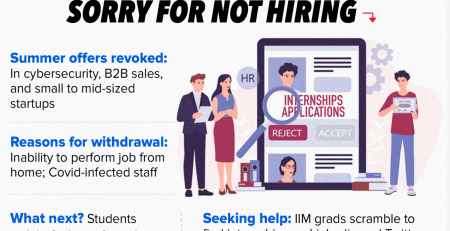Coronavirus and the course of Indian Economy for FY21
Coronavirus and the course of Indian Economy for FY21
India’s COVID-19 numbers are surging. In terms of the total number of infections, the country has rapidly risen through the ranks to now occupy the third place in the world, behind the US and Brazil, having overtaken Russia over the weekend. The first confirmed case in India was reported on January 30. A university student studying in Wuhan, China, had traveled back home to Kerala, a state on India’s southern tip, during vacation. Over the next four days, two more people in Kerala tested positive for the disease. Let’s see the course of our Indian economy during the pandemic.
Prepare for CAT with this course curated by IIM and SP Jain Alumni
India’s performance against COVID-19 is notably bad despite being one of the first emerging economies to announce the lockdown. Thus, it has been obvious for some time that India will emerge from the Covid-19 recession with a record fiscal deficit, record public debt (both in relation to GDP), a fresh lease of life for the “twin-balance sheet crisis” confronting banks and companies, complex monetary challenges, and consequently reduced growth potential.
The economists describe the future growth trajectory as not V-shaped (a quick down and then up), as two optimistic economists have forecasted the month before, or U-shaped (recovery after a time-lapse), or W-shaped, or L-shaped, but K-shaped. This last has two lines diverging from a perpendicular making it look like the letter K. It is this year’s discovery by the global commentariat to describe what has been happening in varying degrees since the financial crisis of 2008: The growing gap between winners and losers among countries, economic sectors, companies, and, of course, people.
Why this is the right time to enroll for MBA
This description of the economy fairly captures the two separate paths of the recovery. The line heading upward symbolizes those parts of the economy that have benefited from pandemic: Technology (Apple Inc., Alphabet Inc., Microsoft Corp.), general merchandise retailers (Target, Walmart), entertainment (Netflix Inc., Walt Disney Co., YouTube), Biotech and Pharmaceuticals (Moderna Inc., Johnson & Johnson & Johnson, Merck & Co., Pfizer Inc., AstraZeneca PLC) work from home firms (Slack Technologies Inc., Zoom Video Communications Inc.) and online retailers (Amazon.com Inc., Shopify Inc.).
Get mentored by top IIM scorers
The line heading downward symbolizes, well, pretty much everyone else. We see this reflected in how various S&P 500 Index sector funds have performed. Technology (Technology Select Sector SPDR Fund), Communications (Communication Services Select Sector SPDR Fund), and Consumer Discretionary (Consumer Discretionary Select Sector SPDR Fund) are up 31.6%, 18.4%, and 16.9%. The three worst-performing broad sectors, Energy (Energy Select Sector SPDR Fund), Financials (Financial Select Sector SPDR Fund), and Utilities (Utilities Select Sector SPDR Fund) are down 40.3%, 18.7%, and 8.2%.
The pandemic and lockdown have only a bad situation even worse for the Indian economy. Both income and wealth distribution has become so lopsided that even its most ardent critics underestimate how disproportionate it is. All of the factors impacting wages and employment are now more pronounced. Economically, there has never been a worse time to be a high school dropout in America. Workers with more education simply have lower unemployment rates, according to the Bureau of Labor Statistics. They also earn more money. This gulf is likely to widen even further in the future.














Leave a Reply
You must be logged in to post a comment.